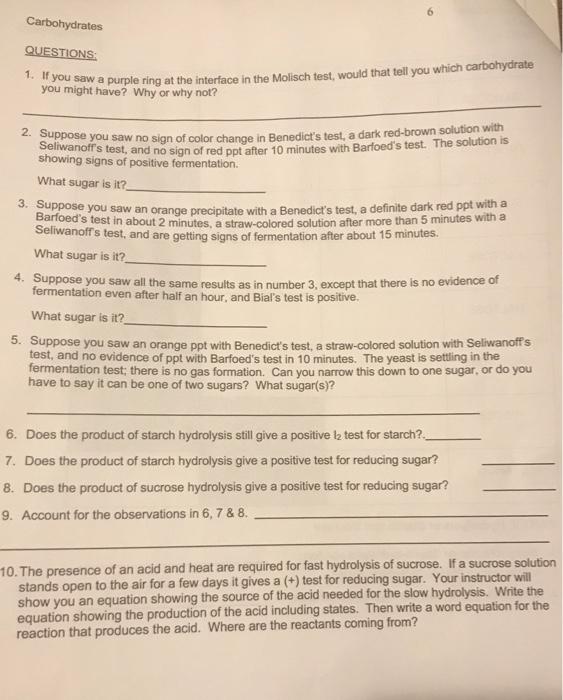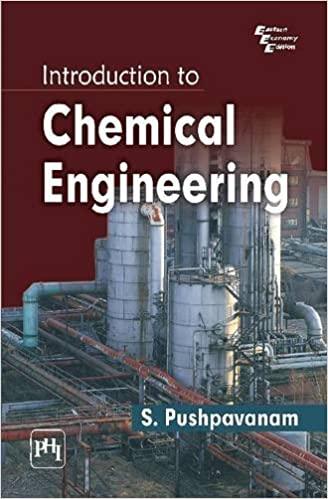Answered step by step
Verified Expert Solution
Question
1 Approved Answer
QUESTIONS: 1. If you saw a purple ring at the interface in the Molisch test, would that tell you which carbohydrate you might have? Why
 QUESTIONS: 1. If you saw a purple ring at the interface in the Molisch test, would that tell you which carbohydrate you might have? Why or why not? 2. Suppose you saw no sign of color change in Benedict's test, a dark red-brown solution with Seliwanoff's test, and no sign of red ppt after 10 minutes with Barfoed's test. The solution is showing signs of positive fermentation. What sugar is it? 3. Suppose you saw an orange precipitate with a Benedict's test, a definite dark red ppt with a Barfoed's test in about 2 minutes, a straw-colored solution after more than 5 minutes with a Seliwanoff's test, and are getting signs of fermentation after about 15 minutes. What sugar is it? 4. Suppose you saw all the same results as in number 3, except that there is no evidence of fermentation even after half an hour, and Bial's test is positive. What sugar is it? 5. Suppose you saw an orange ppt with Benedict's test, a straw-colored solution with Seliwanoff's test, and no evidence of ppt with Barfoed's test in 10 minutes. The yeast is settling in the fermentation test; there is no gas formation. Can you narrow this down to one sugar, or do you have to say it can be one of two sugars? What sugar(s)? 6. Does the product of starch hydrolysis still give a positive h2 test for starch?. 7. Does the product of starch hydrolysis give a positive test for reducing sugar? 8. Does the product of sucrose hydrolysis give a positive test for reducing sugar? 9. Account for the observations in 6,7&8. 10. The presence of an acid and heat are required for fast hydrolysis of sucrose. If a sucrose solution stands open to the air for a few days it gives a (+) test for reducing sugar. Your instructor will show you an equation showing the source of the acid needed for the slow hydrolysis. Write the equation showing the production of the acid including states. Then write a word equation for the reaction that produces the acid. Where are the reactants coming from
QUESTIONS: 1. If you saw a purple ring at the interface in the Molisch test, would that tell you which carbohydrate you might have? Why or why not? 2. Suppose you saw no sign of color change in Benedict's test, a dark red-brown solution with Seliwanoff's test, and no sign of red ppt after 10 minutes with Barfoed's test. The solution is showing signs of positive fermentation. What sugar is it? 3. Suppose you saw an orange precipitate with a Benedict's test, a definite dark red ppt with a Barfoed's test in about 2 minutes, a straw-colored solution after more than 5 minutes with a Seliwanoff's test, and are getting signs of fermentation after about 15 minutes. What sugar is it? 4. Suppose you saw all the same results as in number 3, except that there is no evidence of fermentation even after half an hour, and Bial's test is positive. What sugar is it? 5. Suppose you saw an orange ppt with Benedict's test, a straw-colored solution with Seliwanoff's test, and no evidence of ppt with Barfoed's test in 10 minutes. The yeast is settling in the fermentation test; there is no gas formation. Can you narrow this down to one sugar, or do you have to say it can be one of two sugars? What sugar(s)? 6. Does the product of starch hydrolysis still give a positive h2 test for starch?. 7. Does the product of starch hydrolysis give a positive test for reducing sugar? 8. Does the product of sucrose hydrolysis give a positive test for reducing sugar? 9. Account for the observations in 6,7&8. 10. The presence of an acid and heat are required for fast hydrolysis of sucrose. If a sucrose solution stands open to the air for a few days it gives a (+) test for reducing sugar. Your instructor will show you an equation showing the source of the acid needed for the slow hydrolysis. Write the equation showing the production of the acid including states. Then write a word equation for the reaction that produces the acid. Where are the reactants coming from

Step by Step Solution
There are 3 Steps involved in it
Step: 1

Get Instant Access to Expert-Tailored Solutions
See step-by-step solutions with expert insights and AI powered tools for academic success
Step: 2

Step: 3

Ace Your Homework with AI
Get the answers you need in no time with our AI-driven, step-by-step assistance
Get Started


